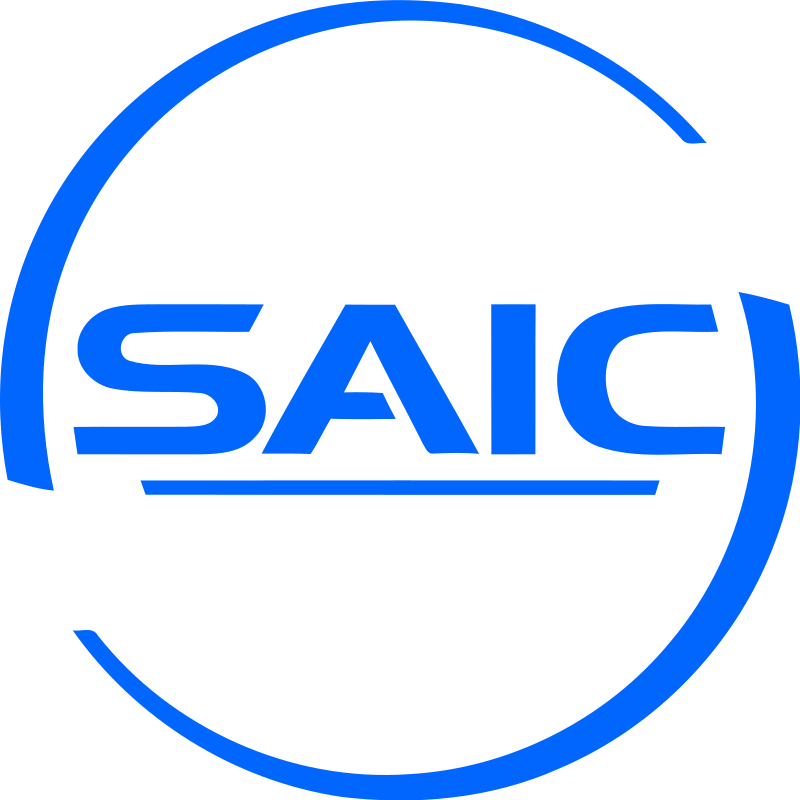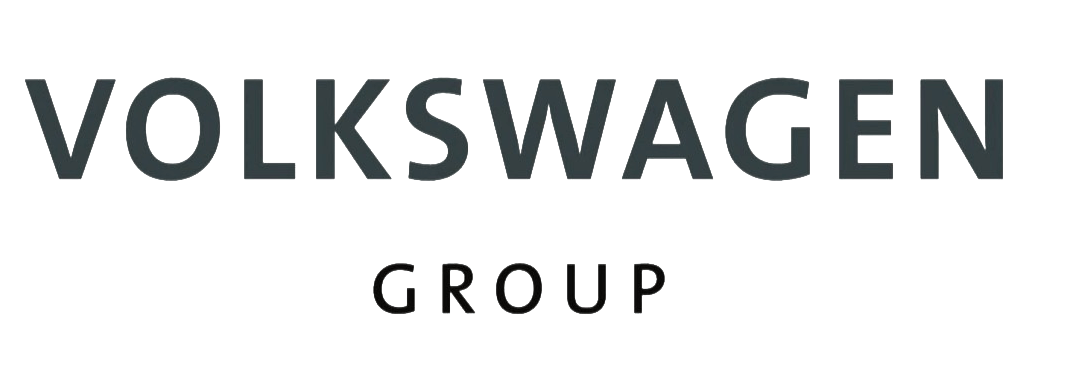Global 5G in Automotive and Smart Transportation Market By Component, By Application, By End User, By Region & Segmental Insights Trends and Forecast, 2024 – 2034
- Industry: Automotive & Transportation
- Report ID: TNR-110-1277
- Number of Pages: 420
- Table/Charts : Yes
- August, 2024
- Base Year : 2024
- No. of Companies : 10+
- No. of Countries : 29
- Views : 10047
- Covid Impact Covered: Yes
- War Impact Covered: Yes
- Formats : PDF, Excel, PPT
The global 5G in automotive and smart transportation market is revolutionizing the industry by enabling ultra-fast, low-latency communication essential for autonomous vehicles, vehicle-to-everything (V2X) communication, and smart traffic management systems. Software solutions like advanced driver assistance systems (ADAS), real-time data analytics platforms, and cloud-based vehicle management systems are pivotal in harnessing the potential of 5G. “The global 5G in automotive and smart transportation market generated revenue of US$ 2.3 billion in 2023 and is expected to grow at a compound annual growth rate (CAGR) of 34.8% from 2024 to 2034.”
As demand for technologically advanced systems and software continues to grow, 5G’s role becomes increasingly critical in ensuring seamless connectivity, safety, and efficiency. It supports real-time decision-making and enhances vehicle performance and infrastructure communication, making it indispensable for the future of smart transportation and autonomous driving technologies.
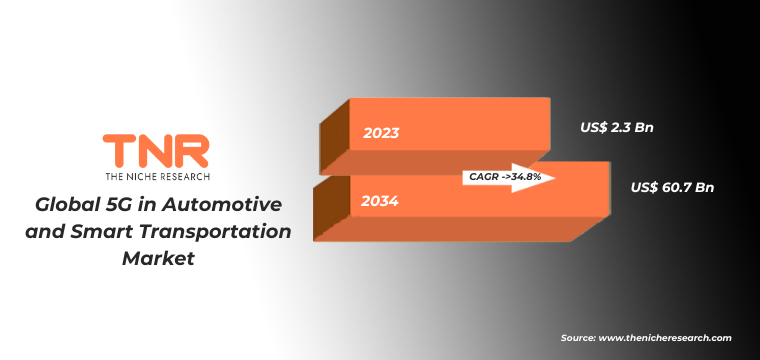
Global 5G in Automotive and Smart Transportation Market Segmental Analysis:
Global 5G in Automotive and Smart Transportation Market By Component
Software solutions are set to play a crucial role in the global 5G in automotive and smart transportation market in the coming years. As technology becomes integral to every industry, its impact on the automotive sector is particularly profound. In automotive, technology drives innovation in areas like autonomous driving, vehicle-to-everything (V2X) communication, and advanced driver assistance systems (ADAS). These advancements enhance safety, efficiency, and connectivity, making vehicles smarter and more responsive. With the rise of 5G, software solutions will be key to managing the complex data and communication needs of modern vehicles, ensuring seamless integration and performance across all aspects of smart transportation.
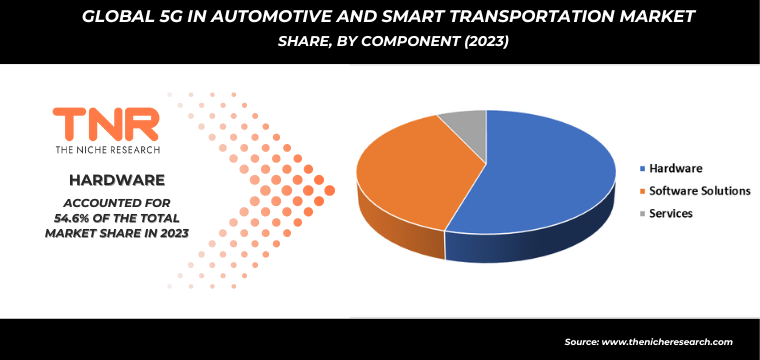
Global 5G in Automotive and Smart Transportation Market By Application
In 2023, vehicle-to-everything (V2X) by application category solidified its dominant position in the global 5G in automotive and smart transportation market. V2X technology enables vehicles to communicate with each other, infrastructure, and pedestrians, enhancing safety, traffic management, and driving efficiency. The adoption of 5G has further accelerated the growth of V2X, allowing for faster data exchange and real-time decision-making. As the automotive industry increasingly embraces smart transportation solutions, V2X remains a critical component in advancing connectivity and automation within the sector.
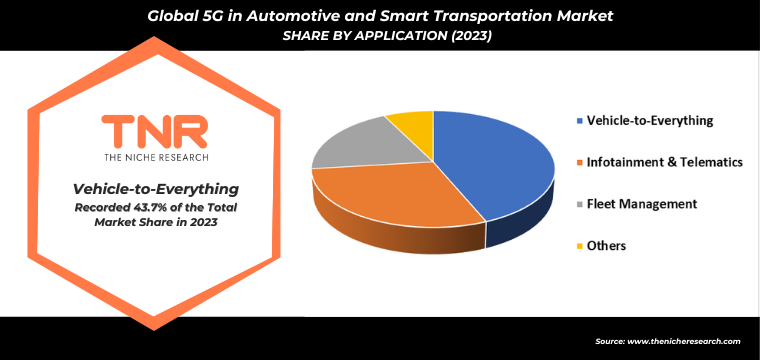
Global 5G in Automotive and Smart Transportation Market By End User
The transportation infrastructure segment by end-user category is poised to play a crucial role in the global 5G in automotive and smart transportation market in the coming years. 5G technology is vital for modernizing transportation infrastructure, enabling real-time data exchange, and enhancing traffic management systems. It supports the development of smart roads, intelligent traffic lights, and connected infrastructure, all of which are essential for improving safety and efficiency. With 5G, transportation networks can better handle the demands of autonomous vehicles and connected cars, ensuring seamless communication between vehicles and infrastructure. This integration will drive significant advancements in the overall efficiency and safety of transportation systems.
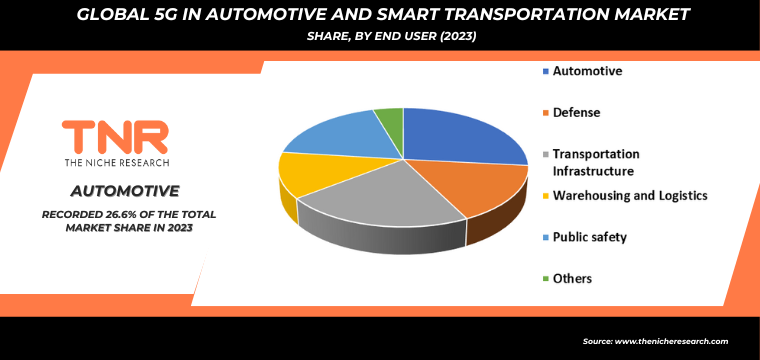
Global 5G in Automotive and Smart Transportation Market By Region
In 2023, North America dominated the global 5G in automotive and smart transportation market, driven by its strong technological leadership and the presence of key manufacturers in the region. Major automotive and technology companies, including those specializing in autonomous vehicles and connected car solutions, are headquartered in North America, contributing to the region’s market dominance. The region’s advanced infrastructure, coupled with its ranking as a global leader in technology innovation, further solidifies its position. North America’s early adoption of 5G technology and strong R&D investments have made it a hub for cutting-edge automotive and transportation advancements.
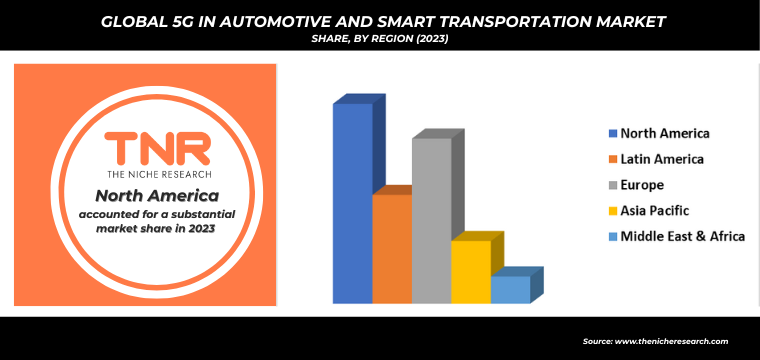
Global 5G in Automotive and Smart Transportation Market Dynamics
Global 5G in Automotive and Smart Transportation Market Growth Driver:
Technological Advancements: The rapid development of autonomous vehicles and V2X communication systems is driving demand for 5G, enhancing connectivity, safety, and real-time data processing.
Government Initiatives: Supportive government policies and investments in smart city infrastructure are accelerating the adoption of 5G in automotive and smart transportation sectors globally.
Rising Consumer Demand: Increasing consumer preference for connected vehicles with advanced features is boosting the integration of 5G technology in automotive and smart transportation systems.
Global 5G in Automotive and Smart Transportation Market Restraint:
High Infrastructure Costs: The significant investment required for 5G infrastructure development, including network towers and data centers, poses a major restraint on market growth.
Regulatory Challenges: Varying regulations across regions and the complexity of integrating 5G with existing automotive systems create hurdles in widespread adoption and implementation.
Data Security Concerns: The increased connectivity in 5G-enabled vehicles raises concerns about data privacy and cybersecurity, which can slow down the adoption of 5G in the automotive sector.
Global 5G in Automotive and Smart Transportation Market Opportunity:
Smart City Integration: Expanding smart city projects globally presents significant opportunities for 5G in enhancing transportation infrastructure, traffic management, and urban mobility solutions.
Emerging Markets: Growing automotive sectors in emerging markets offer vast potential for 5G adoption, driven by increasing investments in advanced transportation technologies and infrastructure.
Partnerships and Collaborations: Strategic alliances between telecom providers, automotive manufacturers, and technology firms can accelerate the development and deployment of 5G solutions in smart transportation.
Global 5G in Automotive and Smart Transportation Market Trends:
Edge Computing Adoption: Increasing integration of edge computing with 5G networks is enhancing real-time data processing in vehicles, leading to more responsive and efficient smart transportation systems.
Connected Vehicle Ecosystems: The rise of connected vehicle ecosystems, leveraging 5G for seamless communication between vehicles and infrastructure, is driving innovations in autonomous driving and smart mobility.
Sustainability Focus: Growing emphasis on sustainable transportation is pushing the adoption of 5G-enabled electric and autonomous vehicles, aligning with global environmental goals and reducing carbon footprints.
Competitive Landscape
Manufacturers are advancing the global 5G in automotive and smart transportation market by developing cutting-edge solutions such as enhanced V2X communication systems, real-time data analytics platforms, and integrated autonomous driving technologies. New innovations include improved connectivity modules, advanced sensors, and software platforms that optimize vehicle performance and traffic management.
- In January 2024, Qualcomm Technologies introduced a range of automotive solutions utilizing its Snapdragon Digital Chassis platform at the CES exhibition. These innovations are designed to advance driver assistance, automated driving systems, connected car technologies, and future digital cockpits.
- In March 2022, Lockheed Martin, a prominent American defense contractor, announced its development of new technologies aimed at connecting military vehicles to 5G networks to improve battlefield communications.
Some of the players operating in the 5G in automotive and smart transportation market are
- Audi Group
- BMW Group
- Daimler AG
- Deutsche Telekom AG
- Huawei Device Co. Ltd.
- Mercedes-Benz
- Nokia
- Qualcomm Technologies Inc.
- Robert Bosch GmbH
- Telefonaktiebolaget LM Ericsson
- Telefónica S.A.
- Verizon
- Vodafone Limited
- Volkswagen
- Other Industry Participants
Global 5G in Automotive and Smart Transportation Market Scope:
| Report Specifications | Details |
| Market Revenue in 2023 | US$ 2.3 Bn |
| Market Size Forecast by 2034 | US$ 60.7 Bn |
| Growth Rate (CAGR) | 34.8% |
| Historic Data | 2016 – 2022 |
| Base Year for Estimation | 2023 |
| Forecast Period | 2024 – 2034 |
| Report Inclusions | Market Size & Estimates, Market Dynamics, Competitive Scenario, Trends, Growth Factors, Market Determinants, Key Investment Segmentation, Product/Service/Solutions Benchmarking |
| Segments Covered | By Component, By Application, By End User, By Region |
| Regions Covered | North America, Europe, Asia Pacific, Middle East & Africa, Latin America |
| Countries Covered | U.S., Canada, Mexico, Rest of North America, France, The UK, Spain, Germany, Italy, Nordic Countries (Denmark, Finland, Iceland, Sweden, Norway), Benelux Union (Belgium, The Netherlands, Luxembourg), Rest of Europe, China, Japan, India, New Zealand, Australia, South Korea, Southeast Asia (Indonesia, Thailand, Malaysia, Singapore, Rest of Southeast Asia), Rest of Asia Pacific, Saudi Arabia, UAE, Egypt, Kuwait, South Africa, Rest of Middle East & Africa, Brazil, Argentina, Rest of Latin America |
| Key Players | Audi Group, BMW Group, Daimler AG, Deutsche Telekom AG, Huawei Device Co. Ltd., Mercedes-Benz, Nokia, Qualcomm Technologies Inc., Robert Bosch GmbH, Telefonaktiebolaget LM Ericsson, Telefónica S.A., Verizon, Vodafone Limited, Volkswagen |
| Customization Scope | Customization allows for the inclusion/modification of content pertaining to geographical regions, countries, and specific market segments. |
| Pricing & Procurement Options | Explore purchase options tailored to your specific research requirements |
| Contact Details | Consult With Our Expert
Japan (Toll-Free): +81 663-386-8111 South Korea (Toll-Free): +82-808- 703-126 Saudi Arabia (Toll-Free): +966 800-850-1643 United Kingdom: +44 753-710-5080 United States: +1 302-232-5106 E-mail: askanexpert@thenicheresearch.com
|
Global 5G in Automotive and Smart Transportation Market
By Component
- Hardware
- 5G Modules
- Antennas
- Communication Chips
- On-Board Units (OBUs)
- Sensors
- Others
- Software Solutions
- Services
- Professional Services
- Consulting
- Integration
- Support and Maintenance
- Managed Services
- Professional Services
By Application
- Vehicle-to-Everything
- Infotainment & Telematics
- Fleet Management
- Others
By End User
- Automotive
- Defense
- Transportation Infrastructure
- Warehousing and Logistics
- Public safety
- Others
By Region
- North America (U.S., Canada, Mexico, Rest of North America)
- Europe (France, The UK, Spain, Germany, Italy, Nordic Countries (Denmark, Finland, Iceland, Sweden, Norway), Benelux Union (Belgium, The Netherlands, Luxembourg), Rest of Europe)
- Asia Pacific (China, Japan, India, New Zealand, Australia, South Korea, Southeast Asia (Indonesia, Thailand, Malaysia, Singapore, Rest of Southeast Asia), Rest of Asia Pacific)
- Middle East & Africa (Saudi Arabia, UAE, Egypt, Kuwait, South Africa, Rest of Middle East & Africa)
- Latin America (Brazil, Argentina, Rest of Latin America)
Report Layout:
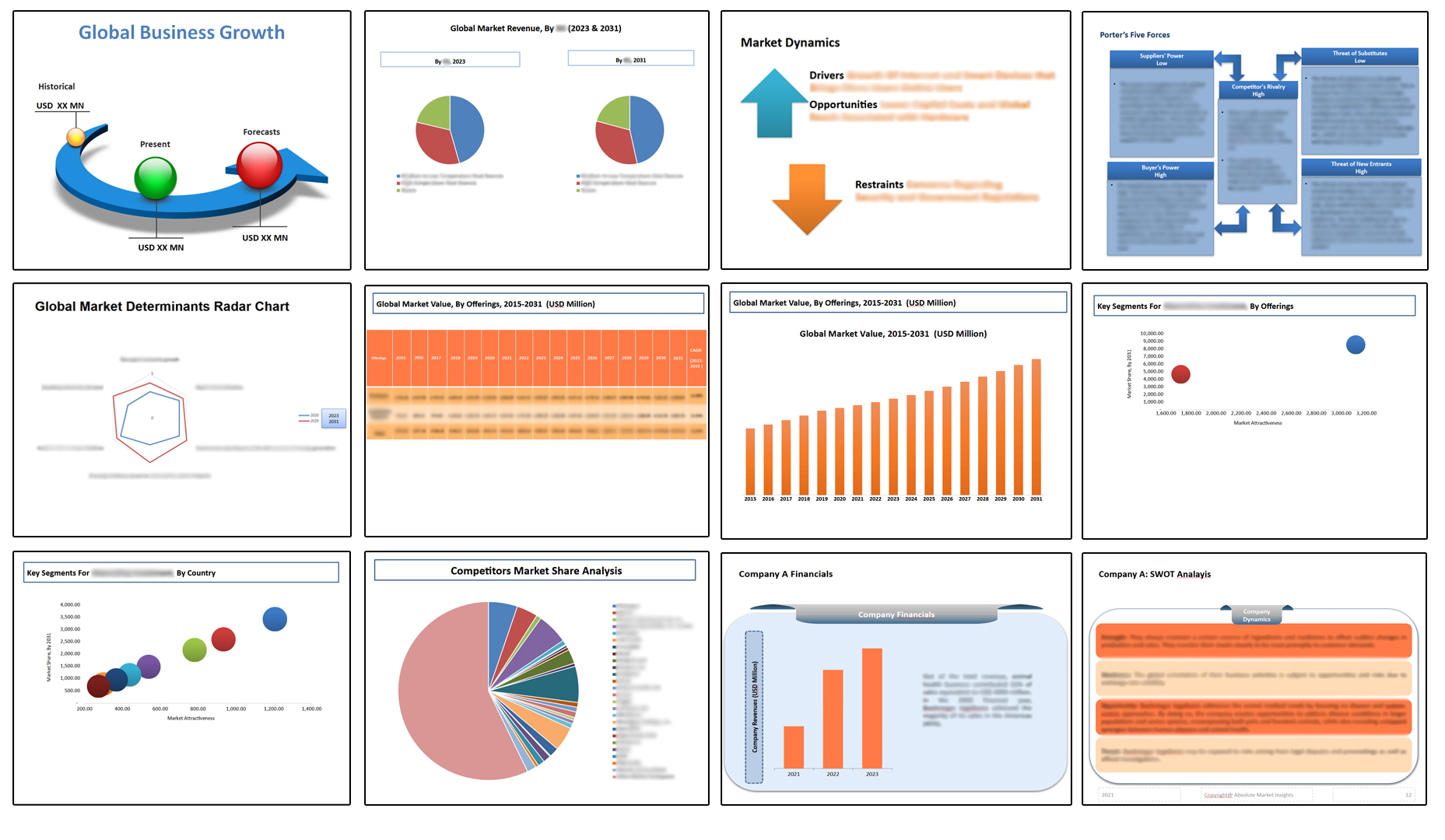
Table of Contents
**Exclusive for Multi-User and Enterprise User.
Global 5G in Automotive and Smart Transportation Market
By Component
- Hardware
- 5G Modules
- Antennas
- Communication Chips
- On-Board Units (OBUs)
- Sensors
- Others
- Software Solutions
- Services
- Professional Services
- Consulting
- Integration
- Support and Maintenance
- Managed Services
- Professional Services
By Application
- Vehicle-to-Everything
- Infotainment & Telematics
- Fleet Management
- Others
By End User
- Automotive
- Defense
- Transportation Infrastructure
- Warehousing and Logistics
- Public safety
- Others
By Region
- North America (U.S., Canada, Mexico, Rest of North America)
- Europe (France, The UK, Spain, Germany, Italy, Nordic Countries (Denmark, Finland, Iceland, Sweden, Norway), Benelux Union (Belgium, The Netherlands, Luxembourg), Rest of Europe)
- Asia Pacific (China, Japan, India, New Zealand, Australia, South Korea, Southeast Asia (Indonesia, Thailand, Malaysia, Singapore, Rest of Southeast Asia), Rest of Asia Pacific)
- Middle East & Africa (Saudi Arabia, UAE, Egypt, Kuwait, South Africa, Rest of Middle East & Africa)
- Latin America (Brazil, Argentina, Rest of Latin America)
The Niche Research approach encompasses both primary and secondary research methods to provide comprehensive insights. While primary research is the cornerstone of our studies, we also incorporate secondary research sources such as company annual reports, premium industry databases, press releases, industry journals, and white papers.
Within our primary research, we actively engage with various industry stakeholders, conducting paid interviews and surveys. Our meticulous analysis extends to every market participant in major countries, allowing us to thoroughly examine their portfolios, calculate market shares, and segment revenues.
Our data collection primarily focuses on individual countries within our research scope, enabling us to estimate regional market sizes. Typically, we employ a bottom-up approach, meticulously tracking trends in different countries. We analyze growth drivers, constraints, technological innovations, and opportunities for each country, ultimately arriving at regional figures.Our process begins by examining the growth prospects of each country. Building upon these insights, we project growth and trends for the entire region. Finally, we utilize our proprietary model to refine estimations and forecasts.
Our data validation standards are integral to ensuring the reliability and accuracy of our research findings. Here’s a breakdown of our data validation processes and the stakeholders we engage with during our primary research:
- Supply Side Analysis: We initiate a supply side analysis by directly contacting market participants, through telephonic interviews and questionnaires containing both open-ended and close-ended questions. We gather information on their portfolios, segment revenues, developments, and growth strategies.
- Demand Side Analysis: To gain insights into adoption trends and consumer preferences, we reach out to target customers and users (non-vendors). This information forms a vital part of the qualitative analysis section of our reports, covering market dynamics, adoption trends, consumer behavior, spending patterns, and other related aspects.
- Consultant Insights: We tap into the expertise of our partner consultants from around the world to obtain their unique viewpoints and perspectives. Their insights contribute to a well-rounded understanding of the markets under investigation.
- In-House Validation: To ensure data accuracy and reliability, we conduct cross-validation of data points and information through our in-house team of consultants and utilize advanced data modeling tools for thorough verification.
The forecasts we provide are based on a comprehensive assessment of various factors, including:
- Market Trends and Past Performance (Last Five Years): We accurately analyze market trends and performance data from preceding five years to identify historical patterns and understand the market’s evolution.
- Historical Performance and Growth of Market Participants: We assess the historical performance and growth trajectories of key market participants. This analysis provides insights into the competitive landscape and individual company strategies.
- Market Determinants Impact Analysis (Next Eight Years): We conduct a rigorous analysis of the factors that are projected to influence the market over the next eight years. This includes assessing both internal and external determinants that can shape market dynamics.
- Drivers and Challenges for the Forecast Period:Identify the factors expected to drive market growth during the forecast period, as well as the challenges that the industry may face. This analysis aids in deriving an accurate growth rate projection.
- New Acquisitions, Collaborations, or Partnerships: We keep a close watch on any new acquisitions, collaborations, or partnerships within the industry. These developments can have a significant impact on market dynamics and competitiveness.
- Macro and Micro Factors Analysis:A thorough examination of both macro-level factors (e.g., economic trends, regulatory changes) and micro-level factors (e.g., technological advancements, consumer preferences) that may influence the market during the forecast period.
- End-User Sentiment Analysis: To understand the market from the end-user perspective, we conduct sentiment analysis. This involves assessing the sentiment, preferences, and feedback of the end-users, which can provide valuable insights into market trends.
- Perspective of Primary Participants: Insights gathered directly from primary research participants play a crucial role in shaping our forecasts. Their perspectives and experiences provide valuable qualitative data.
- Year-on-Year Growth Trend: We utilize a year-on-year growth trend based on historical market growth and expected future trends. This helps in formulating our growth projections, aligning them with the market’s historical performance.
Research process adopted by TNR involves multiple stages, including data collection, validation, quality checks, and presentation. It’s crucial that the data and information we provide add value to your existing market understanding and expertise. We have also established partnerships with business consulting, research, and survey organizations across regions and globally to collaborate on regional analysis and data validation, ensuring the highest level of accuracy and reliability in our reports.


